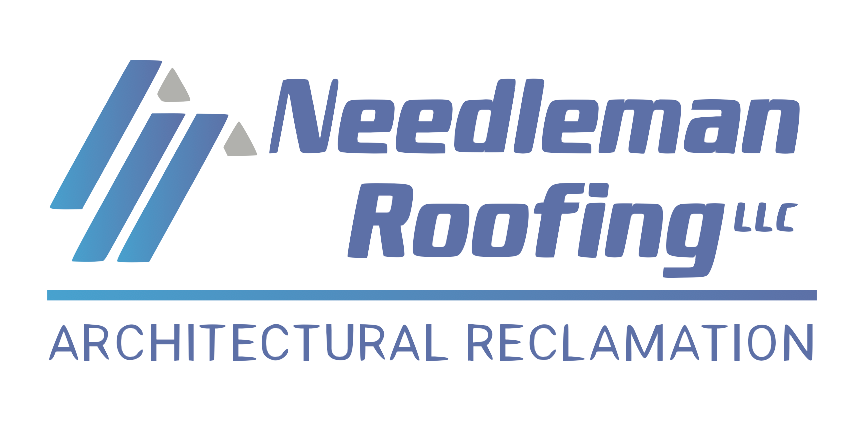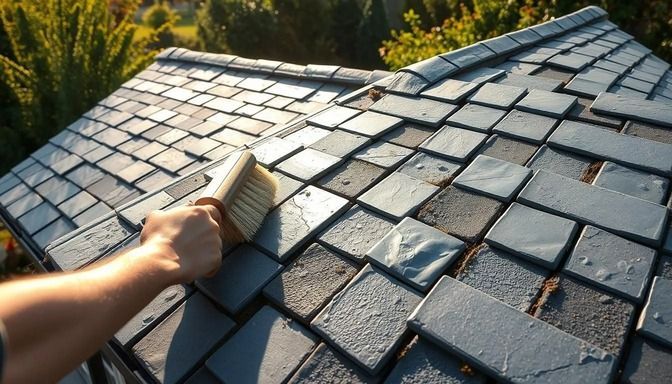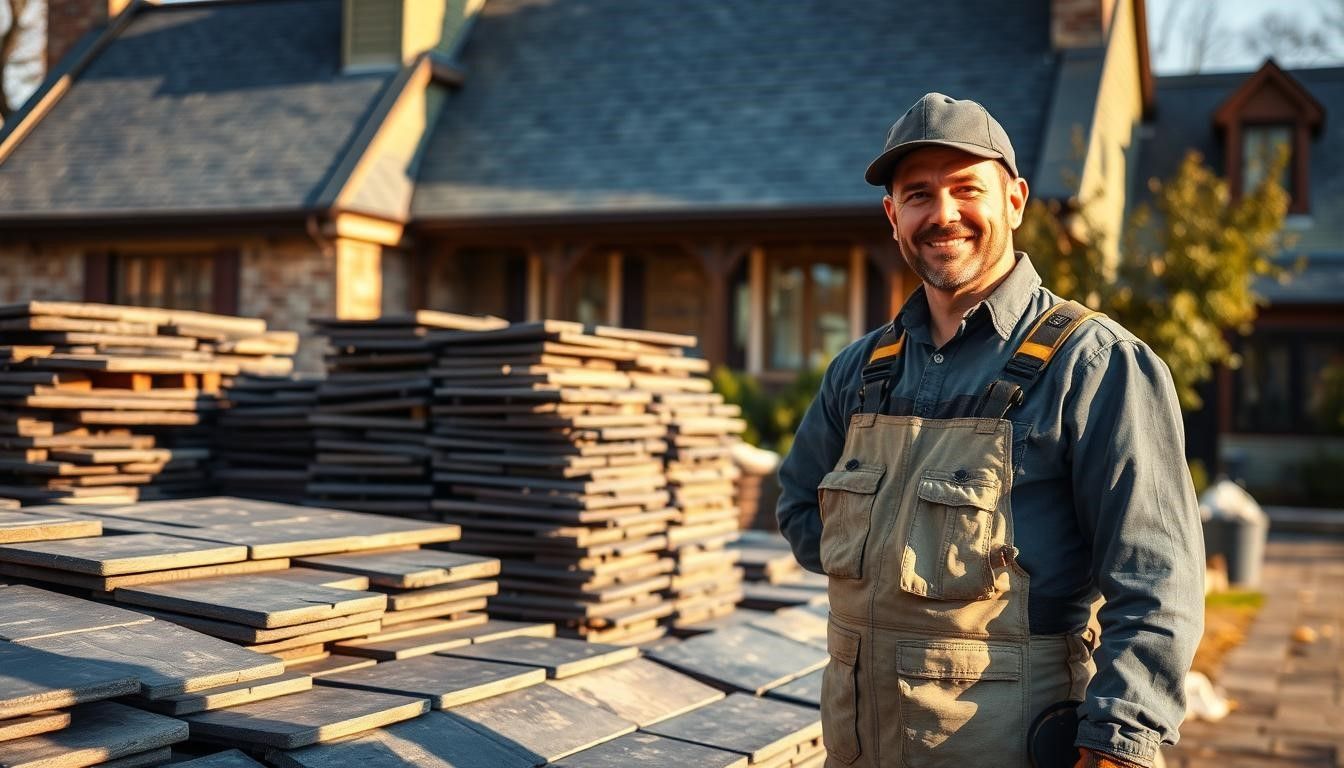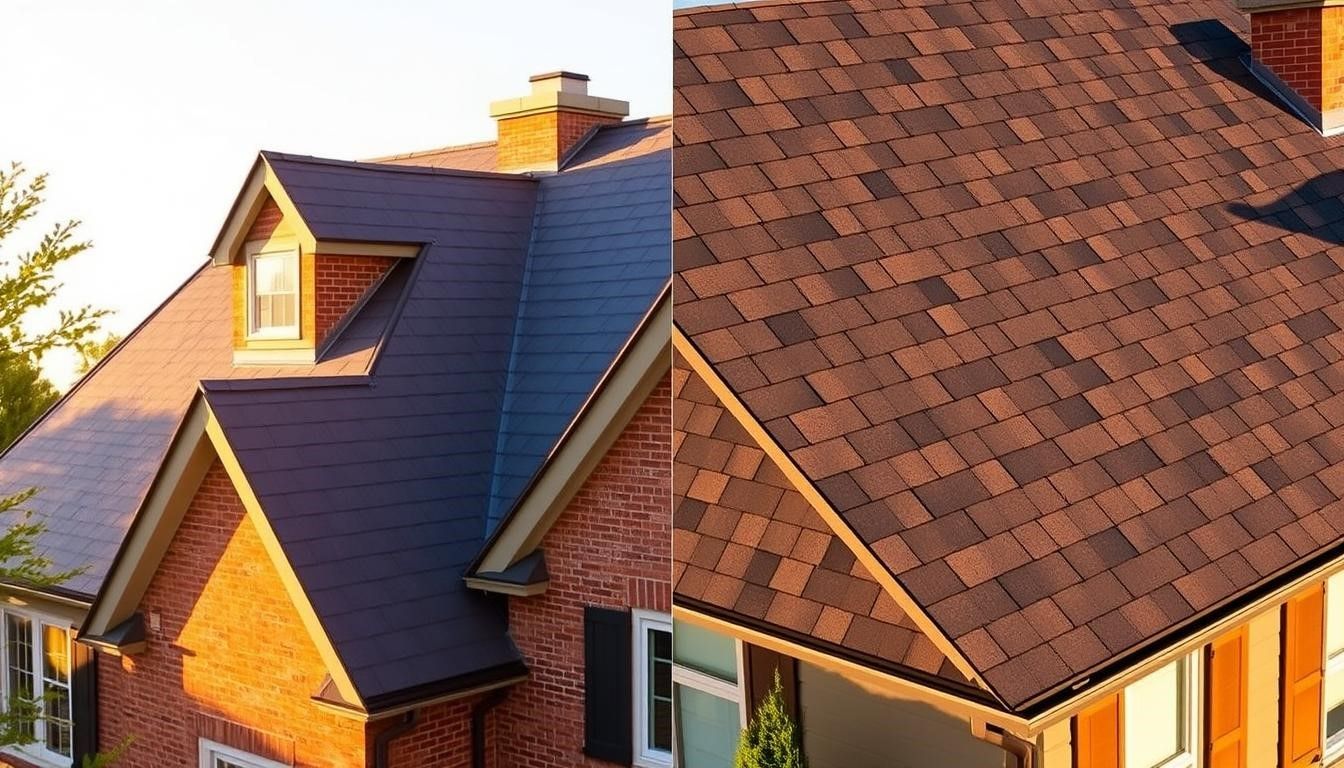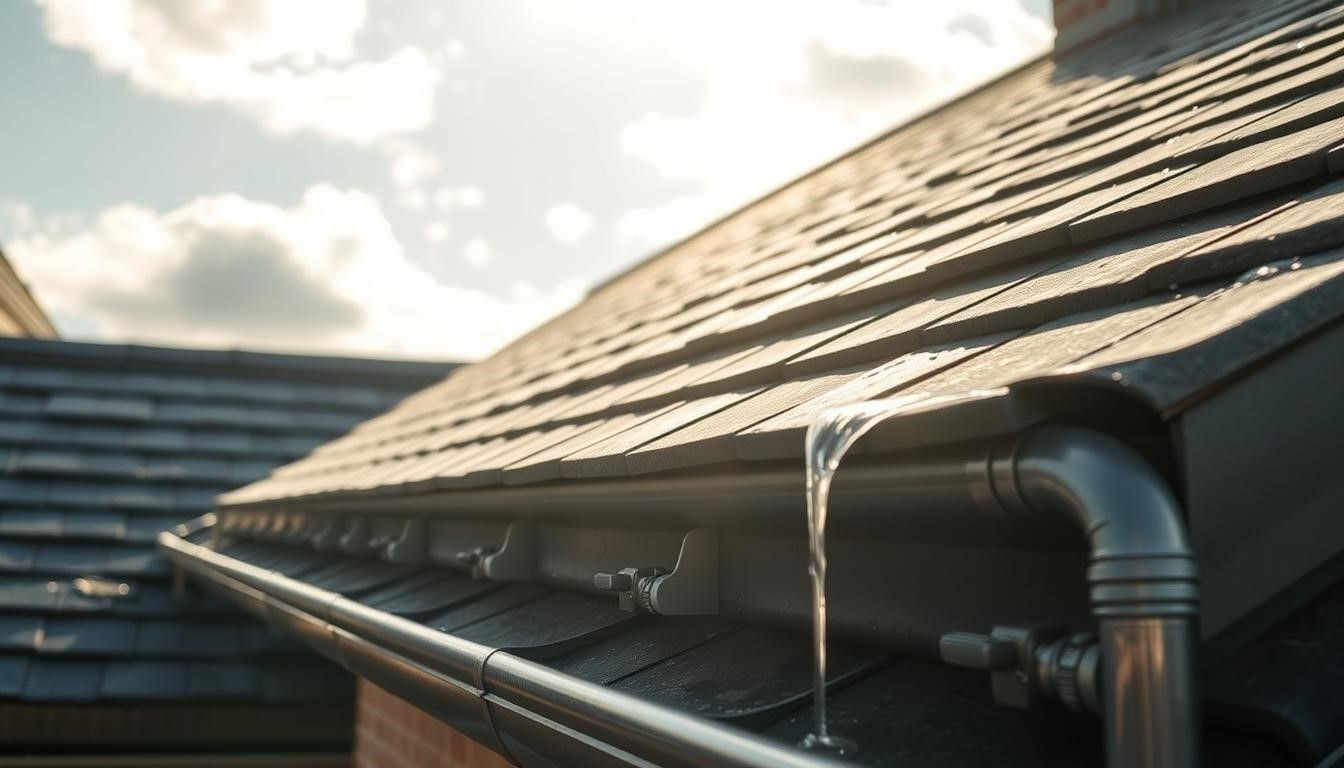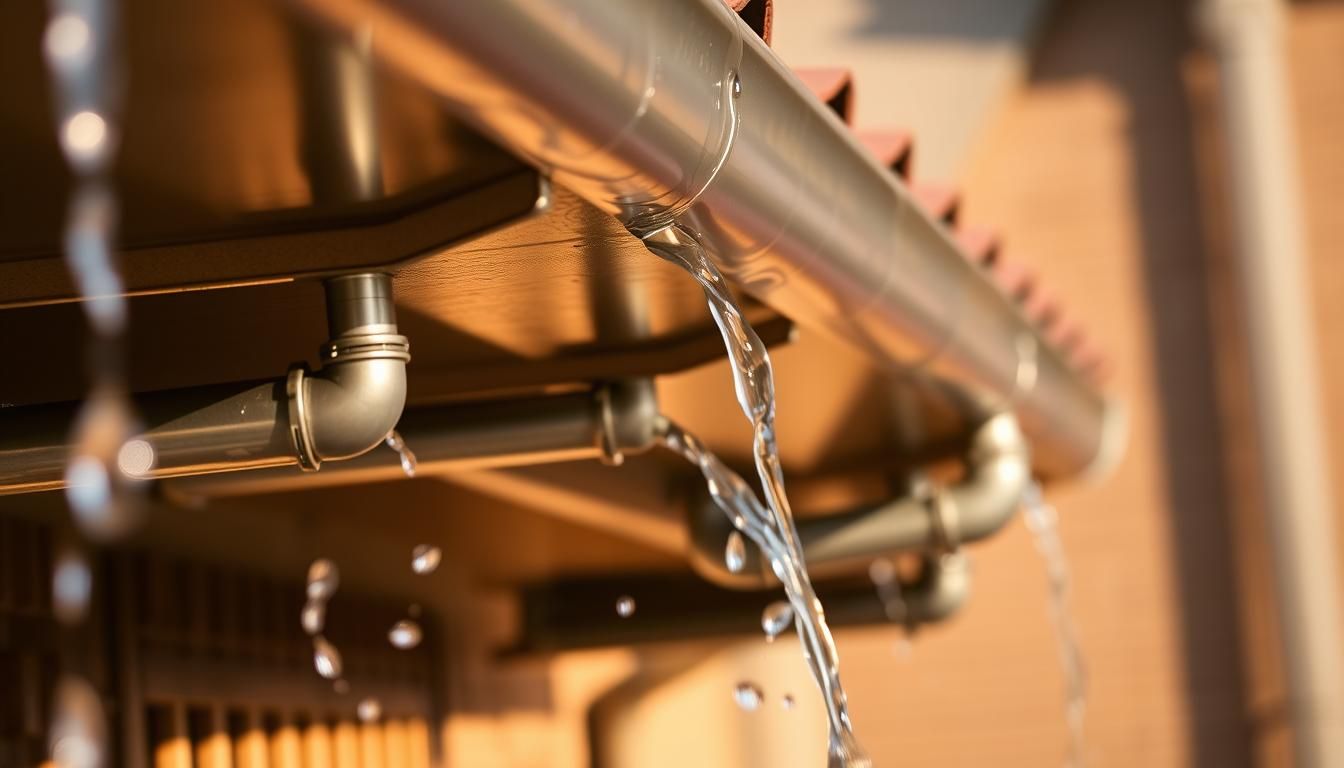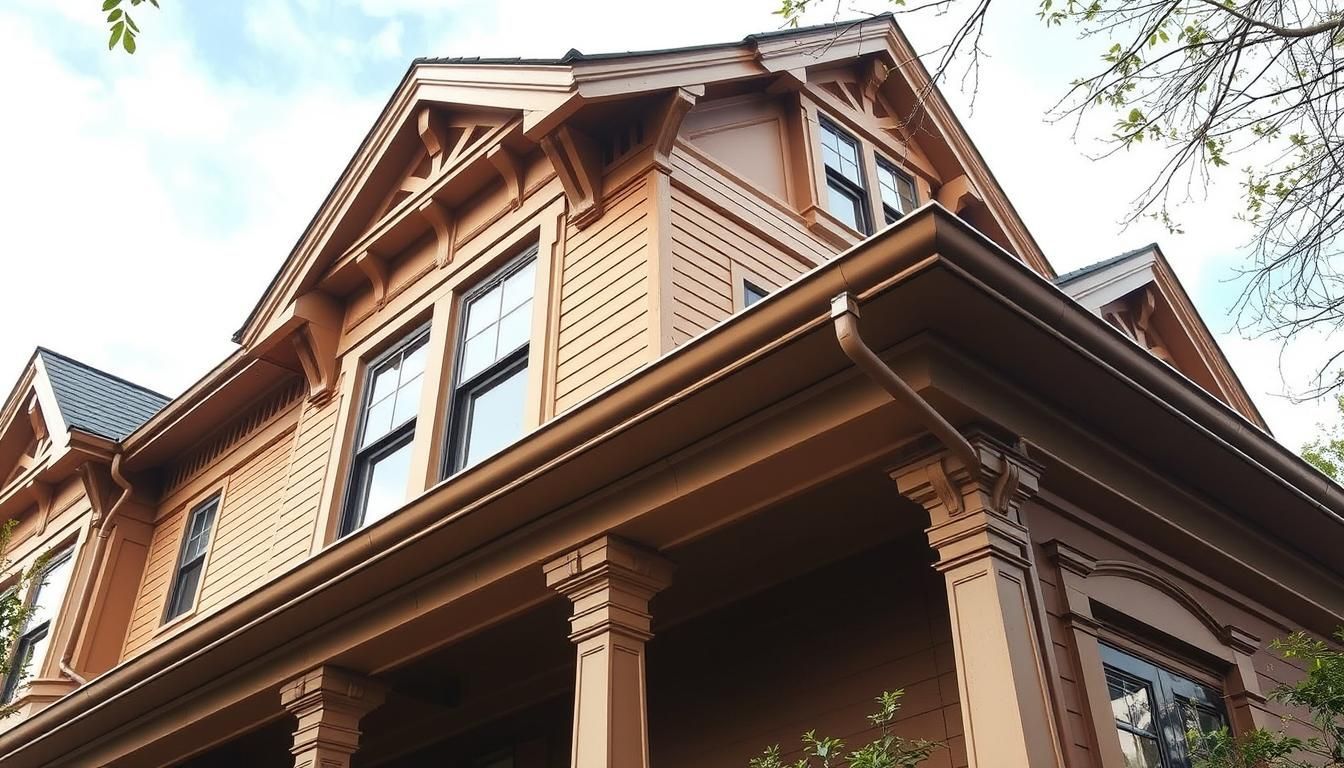The Ultimate Guide to Maintaining Your Slate Roof
Beautiful and Durable Roofing with Slate
Slate roofs are known for their timeless elegance and durability. They add a unique touch to any home. With the right care, a slate roof can last over a century. This makes it a great investment for homeowners.
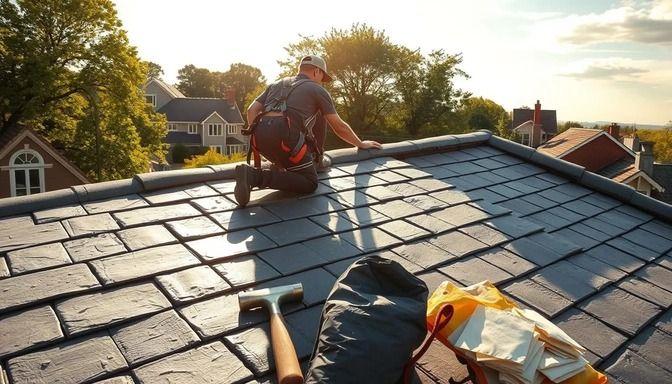
Keeping your slate roof in top shape involves regular cleaning and checking for damage. It's also important to know when to seek professional help. Needleman Roofing LLC, a leading slate and tile expert in New Jersey, is here to assist. For expert advice and service, call 908-389-0200.
Key Takeaways
- Regular cleaning is essential for slate roof maintenance.
- Inspect your slate roof regularly for signs of damage.
- Know when to call a professional for repairs or maintenance.
- Needleman Roofing LLC is a trusted expert in slate roof care.
- Proper maintenance can extend the lifespan of your slate roof.
The Heritage and Value of Slate Roofing
Slate roofing has been a symbol of quality and durability for centuries. It combines heritage with modern functionality. Its ability to resist water, fire, and extreme weather is unmatched.
Why Slate Roofs Are a Premium Investment
Slate roofs are a top choice because of their durability and beauty. They can withstand harsh weather, making them a smart long-term investment. Although they cost more upfront, their long life and low maintenance needs make them worth it.
The Expected Lifespan of a Well-Maintained Slate Roof
A well-cared-for slate roof can last up to 100 years or more. To reach this, regular checks and fixes are key. Slate's durability and resistance to rot, mold, and fire make it a great choice for those looking for a lasting roof.
| Roofing Material | Lifespan | Maintenance Needs |
|---|---|---|
| Slate | Up to 100 years+ | Regular inspections and repairs |
| Asphalt Shingles | 20-30 years | Frequent repairs and replacements |
| Metal Roofing | 30-50 years | Occasional inspections and repairs |
Understanding Your Slate Roof System
Knowing how your slate roof works is crucial for its long life and good performance. A well-kept slate roof can last for many years. But, it needs a full understanding of its parts.
Types of Slate Used in Roofing
Slate roofs are made from natural stone. There are several types, like Virginia slate and Welsh slate. Virginia slate is known for its strength, while Welsh slate is loved for its colors.
Each slate type has its own look and feel. The choice depends on what you like and how much you want to spend.
Critical Components: Flashing, Underlayment, and Fasteners
A slate roof has key parts. Flashing keeps water out around chimneys and vents. The underlayment adds extra protection against moisture. It must be put in right to keep the roof strong.
Fasteners, like nails, hold the slates to the roof. It's important to install and care for these parts well for the roof to work right.
| Component | Function | Importance |
|---|---|---|
| Flashing | Prevents water intrusion around vulnerable areas | High |
| Underlayment | Provides additional protection against moisture | High |
| Fasteners | Secures slates to the roof deck | High |
Essential Safety Precautions for Slate Roof Maintenance
Before starting on your slate roof, it's key to know the safety steps. Slate roof upkeep can be risky if not done right. So, it's important to take the right measures to keep yourself safe.
Having the right safety gear is crucial for slate roof upkeep. You'll need a strong ladder, scaffolding, and personal protective items like harnesses and helmets.
Required Safety Equipment
The right safety tools can greatly lower accident risks during slate roof upkeep. You'll need sturdy ladders that can reach the roof safely, scaffolding for bigger areas, and personal protective equipment like harnesses and helmets. These protect against falls and falling objects.
When to Stay on the Ground vs. When to Climb
Not all maintenance needs you to climb the roof. For small checks, staying on the ground with binoculars works. But for detailed tasks, climbing might be needed. Always wear the right safety gear and think about getting a pro if unsure.
Seasonal Maintenance Calendar for Slate Roofs
To keep your slate roof in great shape, follow this seasonal maintenance guide. Regular upkeep is key to a long-lasting slate roof and avoiding expensive fixes. As New Jersey's premier slate and tile specialist, we stress the need for a seasonal maintenance routine.
Spring Inspection and Cleaning
Spring is the best time to check your slate roof after winter. Look for any damaged, missing, or loose slates. Also, inspect the flashing and chimneys for wear. Clean the roof to remove debris and growth like moss and lichen, which can harm your roof.
Summer Maintenance Tasks
In summer, make sure your roof's ventilation system is working right. This prevents heat buildup. Check for storm damage and fix it quickly. Also, inspect the gutters and downspouts to ensure they're clear and working well.
Fall Preparation and Gutter Maintenance
In fall, get your slate roof ready for winter. Do a detailed inspection and clean the gutters and downspouts. Remove leaves and debris to prevent water from backing up under the slates. Also, check that the flashing is secure and there are no gaps or cracks in the roof.
Winter Monitoring and Emergency Care
Winter is a time to be extra careful with your slate roof. Snow and ice can be dangerous. Watch for ice dams and be ready to handle emergencies fast. Keep your gutters clear to avoid ice buildup. If unsure about winter care, consider a professional's help.
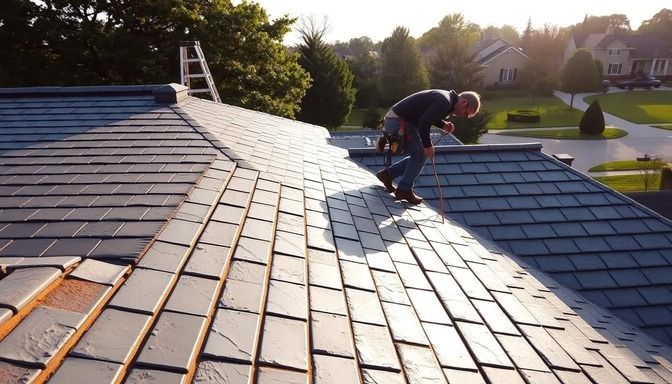
The Ultimate Guide to Maintaining Your Slate Roof: Professional Inspection Techniques
To keep your slate roof in top shape, knowing how pros inspect it is key. Regular checks help spot problems early, before they get big.
Ground-Level Visual Assessments
Inspecting your slate roof starts with a ground-level look. Inspectors look for obvious damage or wear from the ground. They check for missing, broken, or slipped slates.
They also look for water damage or leaks inside your home. This helps spot issues early.
Roof-Level Inspection Methods
To get a closer look, inspectors go up to the roof. There, they examine the slates, flashing, and other important parts. They search for cracks, breaks, or corrosion.
They also make sure everything is securely in place. This ensures the roof is safe and working right.
Documentation and Tracking of Roof Conditions
Keeping a record of your roof's condition is crucial. It helps track what maintenance it needs over time. This involves noting any problems found and repairs done.
Creating a Slate Roof Maintenance Log
A maintenance log for your slate roof is essential. It should list the date of each check, what was found, and any fixes. This log helps keep track of your roof's health and plan for future upkeep.
By using these professional methods, you can keep your slate roof in great shape. This extends its life and keeps it looking good.
| Inspection Date | Findings | Maintenance/Repair |
|---|---|---|
| 2023-03-01 | Missing slate on northwest corner | Replaced missing slate |
| 2023-06-01 | Signs of water damage on ceiling | Inspected and repaired flashing |
Effective Cleaning Procedures for Slate Roofing
Cleaning your slate roof well is key to keeping it in good shape. Regular cleaning makes your roof look better and stops debris and growth that can harm it over time.
Safe Removal of Organic Growth
Moss, algae, and lichen can hurt your slate roof if not cleaned right. Use a soft cleaning solution made for slate roofs. Don't use harsh chemicals or high-pressure washers, as they can damage the slates or lose the granules.
Recommended cleaning solutions are pH-neutral and don't have harsh chemicals. Use a soft-bristled brush or a low-pressure sprayer to remove growth without harming the slates.
Clearing Debris Without Damaging Slates
Leaves and branches can pile up on slate roofs and cause harm or growth. Use a soft-bristled broom or a leaf blower on a low setting to remove debris without scratching or dislodging the slates. Being gentle is crucial to avoid damage.
Appropriate Cleaning Solutions and Tools
The right cleaning solutions and tools are essential for maintaining your slate roof. Use soft-bristled brushes and low-pressure sprayers for cleaning. Stay away from metal tools or abrasive materials that can scratch or damage the slates.
For New Jersey homeowners, we stress the importance of proper cleaning techniques and materials. As New Jersey's top slate and tile specialist, we want your roof to last long and look great.
Identifying and Addressing Common Slate Roof Problems
Even the best slate roofs can face problems that need quick fixes. Slate roofs are tough but can still have issues that affect their life and look.
Cracked, Broken, or Missing Slates
Cracked, broken, or missing slates are big problems for slate roofs. They can let water in, which can harm the roof's base. It's important to check the roof often to find and fix these problems fast. Getting a pro who knows slate roof maintenance is a good idea to make sure repairs are done right.
Slipped or Loose Slates
Slipped or loose slates can happen because of weather or bad installation. If not fixed or replaced, they can cause more damage. Checking the roof regularly can catch these problems early, so they can be fixed quickly.
Deteriorating Flashing and Valleys
Flashing and valleys are key parts of a slate roof. They help keep water away from weak spots. But, they can wear out and cause leaks. It's important to keep an eye on them and fix them to stop water damage.
Nail Fatigue and Fastener Issues
Nails that rust or break can make slate tiles unstable. This can let water in. It's important to check fasteners often and replace them when needed to keep the roof strong.
Fixing these common slate roof problems quickly helps keep the roof in good shape. Regular checks and upkeep are key to spotting problems early and avoiding expensive fixes later.
DIY Slate Roof Maintenance: What Homeowners Can Safely Do
Homeowners can do some DIY slate roof maintenance with the right guidance. While big repairs need pros, there are simple tasks you can do. These help keep your slate roof in top shape.
Basic Slate Replacement Techniques
Replacing a slate tile is easy with the right tools and care. First, find a replacement slate that matches the original. You'll need a slate ripper, a hammer, and nails to secure it. Always work safely on the roof, wearing the right gear and staying steady.
- Carefully remove the damaged slate using a slate ripper.
- Check the area for any other damage or debris.
- Install the new slate, securing it with the right nails.
Simple Flashing Repairs
Flashing is key to your slate roof, keeping water away from weak spots. Simple fixes include resealing or replacing small flashing parts. Use high-quality roofing cement for sealing gaps or cracks. For bigger damage, replacing the flashing is a bit harder but still DIY-friendly for those who are comfortable with heights and roofing.
- Check the flashing for damage or wear.
- Apply roofing cement to seal minor gaps or cracks.
- Replace the flashing if the damage is more serious.
Tools and Materials Every Slate Roof Owner Should Have
Being ready is crucial for maintaining your slate roof. You'll need a slate ripper, roofing cement, a hammer, and roofing nails. Also, have a safety harness and proper footwear for roof work. Regular checks and upkeep can make your slate roof last longer.
- Slate ripper for removing damaged slates.
- Roofing cement for sealing gaps and cracks.
- Safety harness for working at heights.
Doing these DIY tasks helps keep your slate roof strong and long-lasting. But, know when to call pros for big repairs or if you're unsure about anything.
When to Call Needleman Roofing LLC at 908-389-0200
It's important to know when to get help for your slate roof. Some tasks you can do yourself, but others need a pro.
Warning Signs That Require Professional Attention
Look out for these signs to call Needleman Roofing LLC at 908-389-0200:
- Cracked, broken, or missing slates that compromise the roof's integrity
- Signs of nail fatigue or fastener issues that could lead to further damage
- Deteriorating flashing or valleys that risk water intrusion
- Significant moss or algae growth that could damage the slates
Prompt action is key to avoid big repairs.
The Professional Assessment Process
When you call Needleman Roofing LLC, their team will check your roof. They look at:
| Assessment Step | Description |
|---|---|
| Initial Inspection | A detailed visual examination of the roof's condition |
| Damage Identification | Identifying areas of damage or potential weakness |
| Repair Recommendations | Providing a comprehensive plan for necessary repairs |
Needleman Roofing LLC knows how to keep your slate roof in top shape. Call 908-389-0200 for a professional check-up and keep your roof lasting longer.
Advanced Preservation Strategies for Slate Roofs
Keeping a slate roof in top shape requires more than just basic care. Advanced strategies protect it from the environment and boost its natural strength.
Preventative Treatments and Applications
Using preventative treatments is a smart way to care for slate roofs. For example, adding zinc or copper strips along the roof's edge can cut down on cleaning. These metals stop moss and lichen from growing, saving you from frequent upkeep.
Managing Trees and Environmental Factors
It's important to manage trees around your house to protect your slate roof. Trees can be good for shade and cooling, but they can also drop debris and damage the roof. Keeping trees trimmed and planting them wisely can help avoid these problems.
| Strategy | Benefit |
|---|---|
| Zinc/Copper Strips | Reduces organic growth, minimizing cleaning needs |
| Tree Management | Reduces debris and physical damage from branches |
Conclusion: Protecting Your Slate Roof Investment
Maintaining a slate roof is key for its long life and beauty. With the right care, a slate roof can last over a century. This makes it a wise investment that boosts your home's value and looks.
Regular checks, cleanings, and fixes are vital for your slate roof's health. This guide has shown how to keep your roof in top shape. Needleman Roofing LLC, a top slate and tile expert in New Jersey, is here to help.
Keeping your slate roof in good condition needs careful attention and regular care. By focusing on slate roof maintenance, you can enjoy your roof for many years. It's a commitment that pays off in the long run.
Frequently Asked Questions About Slate Roofing
How often should I inspect my slate roof?
You should check your slate roof twice a year, in spring and fall. This helps catch problems early. Needleman Roofing LLC in New Jersey is great for inspections and upkeep.
What are the benefits of maintaining a slate roof?
Keeping your slate roof in good shape can make it last longer and look better. It also saves you money on big repairs. Regular checks can spot issues before they get worse.
How do I clean my slate roof?
Start by removing leaves or branches from your slate roof. Then, use a soft brush and gentle cleaner to remove moss or lichen. Don't use harsh chemicals or high-pressure washes, as they can harm the slates.
What are the most common problems with slate roofs?
Slate roofs often face issues like cracked or missing slates, and loose or slipped slates. Deteriorating flashing and nail fatigue are also common. Regular checks can catch these problems early.
Can I perform DIY maintenance on my slate roof?
Yes, you can do some DIY tasks on your slate roof. This includes replacing slates and fixing flashing. Just make sure you have the right tools and follow safety rules.
When should I call a professional to inspect or repair my slate roof?
If you see cracks, missing slates, leaks, or damaged flashing, call a pro. Needleman Roofing LLC at 908-389-0200 can help. They'll fix your roof and prevent more damage.
How can I prevent moss and algae from growing on my slate roof?
To stop moss and algae, think about adding zinc or copper strips. Regular checks and upkeep can also help keep your roof clean.
What is the expected lifespan of a well-maintained slate roof?
A well-kept slate roof can last 50 years or more. The quality of the slates, installation, and upkeep all play a part. Regular care helps your roof last as long as possible.
